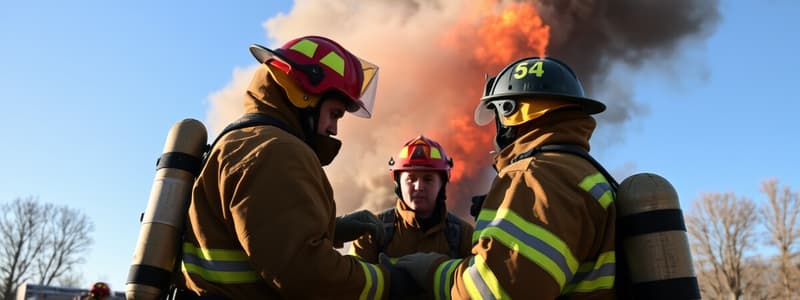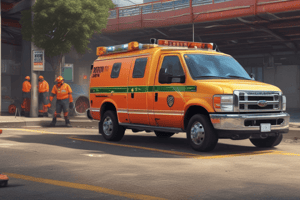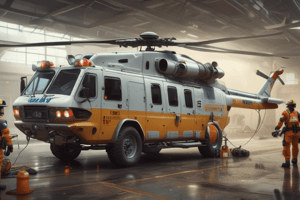Podcast
Questions and Answers
What is the first step to take in a MAYDAY situation?
What is the first step to take in a MAYDAY situation?
- LUNAR or ULUNAR
- Activate PASS
- Inform someone nearby of the emergency (correct)
- Attempt to self rescue
What must an EMS unit NOT do according to established protocols?
What must an EMS unit NOT do according to established protocols?
- Engage before IC orders
- Notify command prior to action
- Respond to known patients (correct)
- Stage outside the collapse zone
In a non-structural fire, who determines the tier of rapid intervention?
In a non-structural fire, who determines the tier of rapid intervention?
- The Incident Commander (IC) (correct)
- The dispatcher
- The unit officer
- The RIC Officer
What must a RIC Officer do prior to engaging in operations?
What must a RIC Officer do prior to engaging in operations?
Which of the following is NOT one of the four primary planning considerations for RIG?
Which of the following is NOT one of the four primary planning considerations for RIG?
What is the preferred method for RIC to resume normal responsibilities?
What is the preferred method for RIC to resume normal responsibilities?
What should personnel do after declaring a MAYDAY with the phrase 'MAYDAY' three times?
What should personnel do after declaring a MAYDAY with the phrase 'MAYDAY' three times?
What action is NOT appropriate for non-MAYDAY personnel?
What action is NOT appropriate for non-MAYDAY personnel?
Which situations require a MAYDAY to be called?
Which situations require a MAYDAY to be called?
What is a primary requirement for the firefighter in charge of the Rapid Intervention Team?
What is a primary requirement for the firefighter in charge of the Rapid Intervention Team?
What must the officer of the first arriving unit announce when entering without two out?
What must the officer of the first arriving unit announce when entering without two out?
What is the initial structure for forming an Initial Entry Team in an IDLH environment?
What is the initial structure for forming an Initial Entry Team in an IDLH environment?
What should an incident report include when entering without two out?
What should an incident report include when entering without two out?
Who can be counted as part of the team to fulfill the two out requirement?
Who can be counted as part of the team to fulfill the two out requirement?
What role do EMS resources play during emergency responses?
What role do EMS resources play during emergency responses?
What is NOT a criterion for initiating a MAYDAY?
What is NOT a criterion for initiating a MAYDAY?
What is the primary method for resolving a MAYDAY situation?
What is the primary method for resolving a MAYDAY situation?
During a MAYDAY, what should personnel do to orient themselves towards an exit point?
During a MAYDAY, what should personnel do to orient themselves towards an exit point?
What is the role of the '2 out' team in the Rapid Intervention protocol?
What is the role of the '2 out' team in the Rapid Intervention protocol?
What does the RIG consist of during structure fires?
What does the RIG consist of during structure fires?
Which is a responsibility of the RIC once they arrive on scene?
Which is a responsibility of the RIC once they arrive on scene?
What is a critical requirement for a firefighter operating under MAYDAY conditions?
What is a critical requirement for a firefighter operating under MAYDAY conditions?
How are special teams determined for rapid intervention?
How are special teams determined for rapid intervention?
What should be prioritized when a MAYDAY is sounded?
What should be prioritized when a MAYDAY is sounded?
Study Notes
Rapid Intervention Team and MAYDAY Procedures
- Rapid Intervention Team (RIT) required in any situation where an Immediately Dangerous to Life or Health (IDLH) scenario is possible or likely.
- Interior Firefighters in Incident Command must have a Tier 2 leader who is Firefighter 3 or an officer.
- Supervisors can delegate proactive tasks but must be ready for a MAYDAY once the Rapid Intervention Group (RIG) is assembled.
- EMS resources are available to care for sick or injured individuals at the scene.
- Officers must carry thermal imagers for enhanced visibility and safety.
- Any unit dispatched after the initial alarm must bring a RIT bag to the command post.
MAYDAY Activation
- A MAYDAY must be called under conditions such as being:
- Entangled, trapped, or pinned.
- Fallen through a roof or floor.
- Involved in a flashover event.
- Off hose line or tag line in zero visibility.
- Experiencing a low air alarm without finding an exit.
- Criteria for initiating a MAYDAY:
- Personal situation meeting MAYDAY conditions.
- Witnessing someone else in a MAYDAY situation.
- Lack of response to multiple radio calls during personnel accountability report (PAR).
Procedure for Initial Entry
- An Initial Entry team must consist of two interior firefighters and one IECS unit officer before entering an IDLH.
- Teams may enter without a 2-out backup only when life hazards are known and acknowledged.
- The first arriving unit officer must announce:
- Units involved in the operation.
- Mission objectives.
- Location of operations.
- If the life hazard is resolved, the team must back out and await the formation of a 2-out team.
2-Out Procedure
- Various personnel may be assigned for the 2-out requirement:
- Personnel from the first arriving unit exceeding minimum staffing.
- Qualified personnel from other units.
- A combination of qualified personnel.
- As a last resort, an EMS unit (not assigned with known patients).
- A 2-out assist/rescue team must notify of problems before entry.
RIC and RIG Procedures
- Rapid Intervention Group (RIG) is established by dispatch and managed by the incident commander (IC).
- During non-structure fires, the IC determines the tier of rapid intervention needed.
- The fifth due engine on-scene is considered the RIC officer and RIG supervisor unless directed otherwise by the IC.
- RIC must maintain readiness and monitor for possible collapse situations.
MAYDAY Response Steps
- Inform someone nearby immediately of the emergency.
- Call MAYDAY three times on the radio.
- Provide information using LUNAR (Location, Unit, Name, Assignment, Resources).
- Attempt self-rescue without waiting for RIT assistance.
- Activate PASS device if applicable.
Non-MAYDAY Personnel Actions
- Personnel can take action to relieve experienced MAYDAY situations while informing supervisors of their actions.
- A small recon team may be deployed to assist in locating firefighters in distress.
Rapid Intervention Strategy
- A four-tiered approach balances mission effectiveness and rapid intervention capabilities:
- 2-Out Stage: Two personnel at the entry point with one maintaining contact with entry teams.
- RIC: First response team that allows 2-out personnel to perform regular duties while remaining ready to intervene.
- RIG Formation: Includes specialized resources for structure fires, ensuring all necessary units are on standby.
- Special Teams: Formed as directed by the IC based on specific incident needs.
Policy and General Guidelines
- Command officers must adapt to dynamic situations where rapid intervention is necessary.
- Effective MAYDAY handling involves thorough preparation, prompt self-rescue, and close coordination with nearby teams to facilitate efficient assistance.
Studying That Suits You
Use AI to generate personalized quizzes and flashcards to suit your learning preferences.
Related Documents
Description
Test your knowledge on Rapid Intervention Team (RIT) protocols and MAYDAY procedures critical for firefighter safety. This quiz covers essential scenarios where a MAYDAY might be necessary and the responsibilities of incident commanders. Ensure you're prepared for emergency responses in life-threatening situations.




